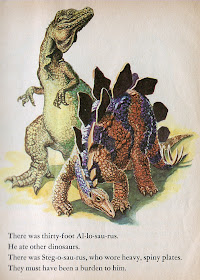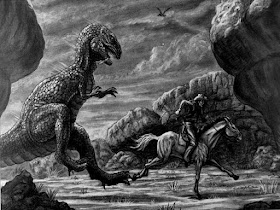Therefore, rather than produce yet another gushing retrospective on the awe and the majesty and the dinosaurs truly being brought to life and that amazing range of huge, rubbery toys, etc. etc., I thought it would be a lot more entertaining for the dino-geek-o-blog-o-sphere to hear what it's like for an outsider to see Jurassic Park for the first time...in 2013. With an enthusiast in tow. Oh dear.
"WHAT?! You haven’t seen it?!"
No. I had never. I admitted over and over again. "Why haven’t you seen it?" I don’t know. My parents never watched it and as I was just an annoying four-year old toddler at the time it was released, I hadn't either. They probably wouldn’t have allowed me to anyway. All those scary animals. No, I had a safe childhood with my Disney films and Lego and such.
So, yes. YES. I had never seen it - the big movie - ever in my life. It must have been one of the biggest disappointments that my coughdinolovinggeekyboyfriendcough (no offence, my dears. Nor to everyone who reads this) had experienced since he was going out with me.
No. NO. I had never seen Jurassic Park.
So a long period of convincing the girlfriend started. Even though he didn’t nag, there were slight but clear signals that I should give in and watch. Sometimes he would say: "They're expensive, they're noisy, they smell..." when I was once again pointing out a sweet, beautiful, little baby two metres away from us. I felt offended and started a ramble about why babies are nice and that he was one once as well. Well, I guessed the latter.. More of those quotes which made me frown followed in his apparently 'convincing girlfriend period'. "Nice hat. What are you trying to look like, a secret agent?", "Dinosaurs...eat man. Woman inherits the Earth". WHAT THE….?! Ever since Jurassic Park 3D was about to be released, the pressure got higher and higher...
So last Saturday, the unforgettable 25th of May 2013, we took the train to a city nearby to watch the afternoon show of Jurassic Park 3D in a very quiet cinema. I was all geared up but still didn’t really know what to expect. I was about to watch THE movie while being a complete noob on the topic. In my opinion, it started rather nicely. As you all know palaeontologist Dr. Alan Grant and the lovely Dr. Ellie Sattler find an amazing skeleton and are overwhelmed. Dr. Grant scares the child very well and makes the not so full cinema laugh (they all probably knew this bit). Good start. But suddenly a prick – called John Hammond – decides to fly into the area with his fat ass helicopter to convert them to go over to his fancy theme park. OK, you probably all know this scene. They were converted very easily – too easily - and so it all began.
 |
| Palaeontologists: they just want your money. |
The story continues. With bombastic (but lovely) music, the cars arrive at the visitors’ centre and we get to see a long long explanation of how the dinosaurs came into the park. From finding the mosquito to the breeding and feeding. Of course, it’s quite important to know. You can’t miss it. But where’s the action?! In the meantime I started to feel some affection for the bad ass but very clever Dr Malcolm. Rrrrr. Good for the ladies [I think The Fly remake is next on the cards - M] Anyway, they go on and on and finally they're in the cars, heading for the T. rex area. THE MONSTROUS T. REX! Of course the insidious Mr. Nedry aka Wayne Knight (oh yes, you’ll already know) has sabotaged the whole system. This is where I thought the proper tension finally began. And yes: the T. rex was huge and was going for the kids (of course, the poor kids!) and proper fear was speeding through my veins.
 |
At one point Nedry gets attacked by this dinosaur which looked lovely but wasn’t so lovely after all. At that moment I had to ask the boyfriend which species this was, but he shushed me. Finally I had proper interest in his subject and then all he did was shushing me. As you might understand: I am still offended.
I especially liked the bit where Dr. Grant and the children are sleeping in the tree and suddenly there’s a brachiosaur eating the leaves nearby. Personally, I thought this was a bit for the ladies (which may be sexist. My apologies girls! Girls like dinosaurs too!) who were dragged along with their geeky boyfriends. It was like some sunlight was shining through the film and everything seemed happy in the terrible situation they were in. Somehow I did expect the girl to fall out of the tree though, which – fortunately for her, but slightly disappointing to me – did not happen.
Quickly after that lovely part, we had to go back to the dinosaur terror. The part where the Velociraptor comes through the wall where Dr. Sattler had just switched on the electricity especially scared the blubbers out of me. It didn’t help that Mr. Boyfriend knows the film by every scene and grabbed my arm at the same time as the dinosaur was suddenly appearing.
Anyway, we know how it goes (if you don't then I just don't want to spoil it all) and the children and doctors escape luckily from the Velociraptor because of the scary but now slightly friendly T. rex.
To make a long blog post short: I thought the film was OK, but not too good. I speak from an entirely subjective point here, of course. There was a pretty good story and I think it's a much better Spielberg film than for example War Horse. But I have to admit that the dinosaurs didn't grab me at all. Maybe it's because I am already used to big big animals in films (Life of Pi – to name one) and the dinosaurs weren't CG exceptionnel. I can imagine why this film was such a hit in the '90s though, as animals – and especially dinosaurs – weren’t shown on the big screen like this before. The film was all right, but I am not entirely sure if I will ever buy the DVD, if you get what I mean.
Still I am happy that I have finally, properly, entered the world of the boyfriend now. I don't regret it. Besides that I feel very obliged – as I am the biggest noob in the Universe on this topic - to write a post on this blog. Which by the way is very, very precious to him, dear readers.
Oh, I shouldn’t forget this: the music in the film was great!
A big thanks for reading and well done if you have made it to the end of this post! -- Nicole Heins
 |
| Nicole, recently. |








































